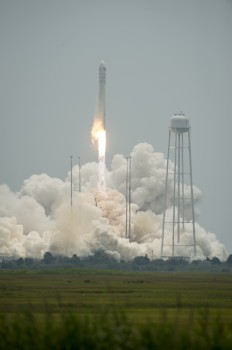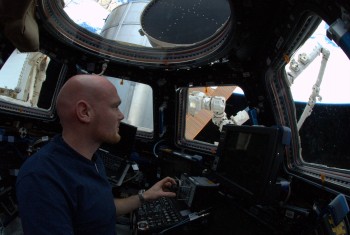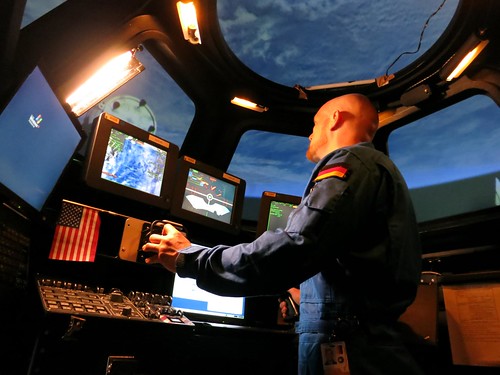After some delays due to bad weather Cygnus’ Orbital-2 supply spacecraft was launched last Sunday from Virginia, USA. The spacecraft was put into the same orbit as the International Space Station but at a lower altitude.
Since then Orbital-2 has been gaining height as it approaches the Station. When the time comes tomorrow for the unmanned supply ship to dock with the Space Station, NASA astronaut-commander Steve Swanson will work with Alexander Gerst to grapple the spacecraft with the 17-meter Canadarm and bring it safely into contact with a berthing port.
Steve will be ‘M1’, operating the robotic arm while Alexander will be ‚M2‘, monitoring the approach, communicating with ground control and commanding the vehicle.
The crew had a few refresher session last week to practice with the robotic arm, setting up a workstation in Europe’s Cupola observatory.
The crew spent 100s of hours before leaving Earth practicing these operations in simulations as the operation requires manoeuvring the arm in six dimension at the same time, while floating in microgravity.
Read ESA astronaut Luca Parmitano recount how he helped grapple the Cygnus test-flight during his Volare mission last year on his blog.
Watch the operation tomorrow. 16 July, live via NASA TV from 9:15 GMT.







Discussion: 4 comments
Hey there,
After reading your article, I have several questions.
What is the difference, if any, between zero gravity and microgravity? Also, what is six dimension?
Wishing you guys a safe and blessed day!
Good questions!
We use the term microgravity because technically the International Space Station and objects inside it still feel Earth’s gravity. The Station is only 400 km above our planet so 90% of Earth’s gravity is still working on it. The astronauts float, because the Space Station moves so fast (28 800 km/h) that by the time gravity pulls it towards Earth, the Station is already past it and ‘falling’ beyond Earth. So the Station is in a permanent free-fall. The astronauts float just as people stuck in an elevator falling down a lift-shaft would.
The short answer: 1 gravity is what we feel at sea level, microgravity is what astronauts feel on the Space Station or 0.0000001 of gravity, and zero gravity is absolutely nothing.
By six dimensions we mean moving left/right (1), up/down (2), forward/backwards (3) but this also includes pitch (4), yaw (5), and role (6). Your head can move in six dimensions, but not freely, as we are limited by the neck. See here for a visual explanation: https://en.wikipedia.org/wiki/Six_degrees_of_freedom#mediaviewer/File:6DOF_en.jpg
thank you, don’t worry, everything going to be all right. thank you!!!
https://www.icloud.com/photostream/es-es/#A25n8hH4Gx2hcb
Do you cross fingers or gloves? Do it, 3 D is OK!
Happiest luck!